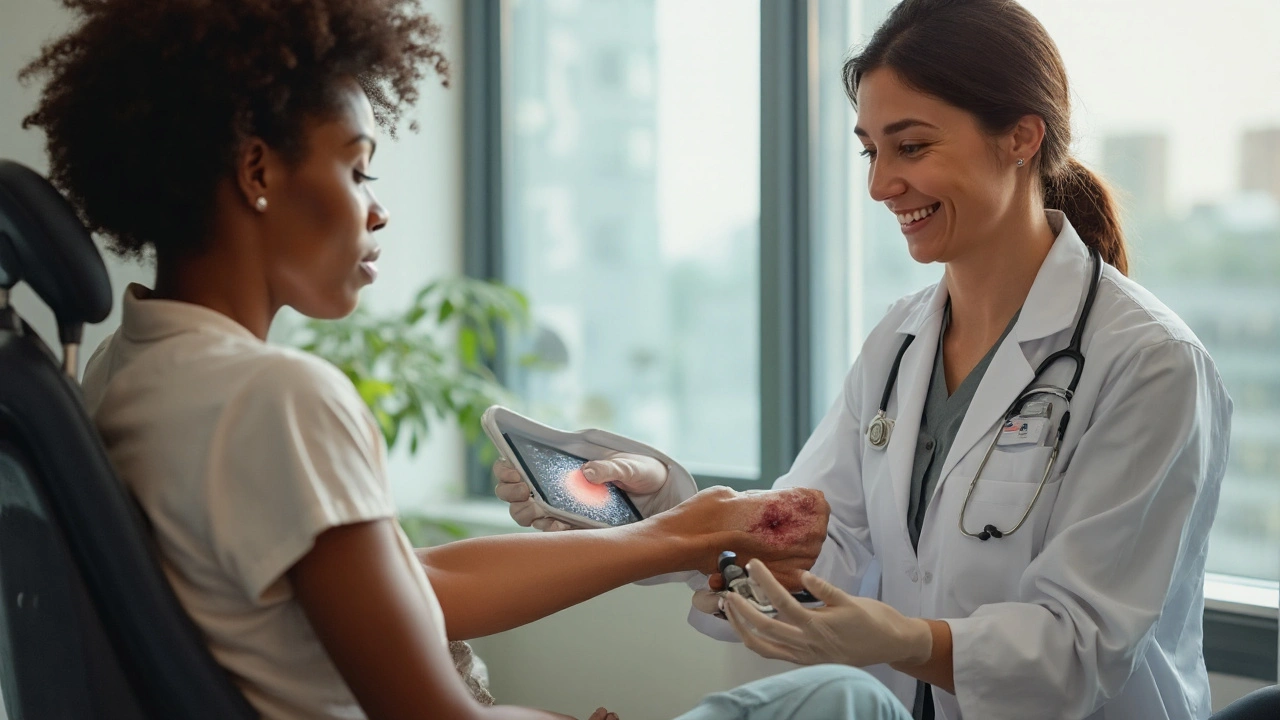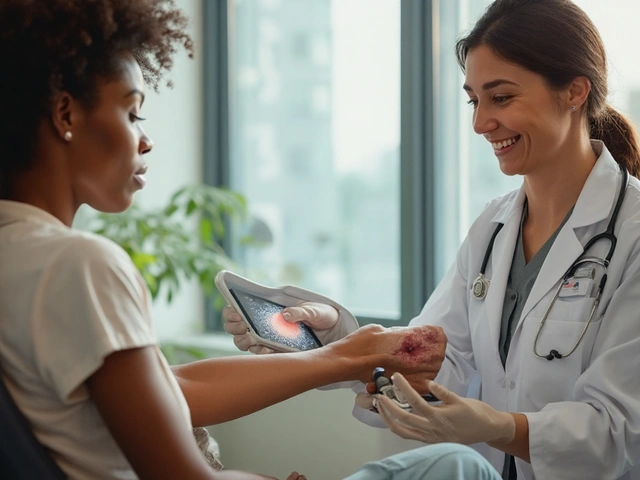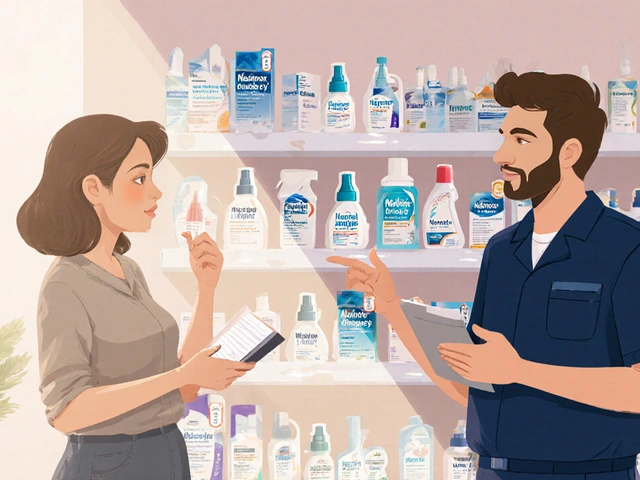Cutaneous candidiasis is a yeast infection of the skin caused primarily by Candida albicans. It typically appears as red, itchy patches in warm, moist areas such as the groin, underarms, and skin folds. Proper identification matters because its signs overlap with eczema, psoriasis, and bacterial infections, leading to mis‑treatment and prolonged discomfort.
Understanding the Common Yeast Culprits
Besides Candida albicans, other yeasts like Malassezia can cause conditions such as pityriasis versicolor, which presents as discolored, scaly patches. Distinguishing between Candida and Malassezia is vital because treatment regimens differ-malassezia often responds to selenium sulfide shampoos, while candidiasis requires antifungal agents.
Symptoms That Prompt a skin yeast infection diagnosis
- Intense itching that worsens with heat or sweating.
- Redness and well‑defined borders, sometimes with satellite lesions.
- Moist, macerated skin that may ooze a cottage‑cheese‑like discharge.
- In chronic cases, thickened or fissured skin, especially in intertriginous zones.
When these signs appear alongside risk factors-diabetes mellitus, obesity, recent antibiotic use, or immunosuppression-clinicians should suspect a yeast infection.
Key Risk Factors and Underlying Conditions
One of the strongest predictors is diabetes mellitus. Elevated blood glucose feeds yeast growth, making diabetic patients up to three times more likely to develop intertriginous candidiasis. Other contributors include excessive moisture from occlusive clothing, hormonal changes, and weakened immune defenses from corticosteroid therapy or HIV infection.
Diagnostic Tools: From Bedside to Lab
The first step is a visual exam, but definitive diagnosis relies on simple, low‑cost tests.
- KOH preparation: A scraping of the lesion is mixed with 10% potassium hydroxide and examined under a microscope. The presence of budding yeast cells or pseudohyphae confirms candidal involvement.
- Fungal culture: The specimen is plated on Sabouraud dextrose agar and incubated for 48‑72 hours. Culture identifies the species and checks for antifungal resistance.
- Wood's lamp examination: Useful for Malassezia infections, which fluoresce yellow‑green under UV light.
Advanced labs now offer PCR‑based assays that rapidly pinpoint Candida species, but cost and availability limit routine use.

Comparing Treatment Options
| Attribute | Topical Antifungal | Systemic Antifungal |
|---|---|---|
| Route | Applied directly to skin | Oral ingestion |
| Typical Indications | Localized Candida infection, mild cases | Extensive or recurrent infection, immunocompromised patients |
| Onset of Relief | 2‑4 days | 5‑7 days |
| Common Agents | Clotrimazole, Miconazole, Terbinafine | Fluconazole, Itraconazole |
| Side‑Effect Profile | Local irritation, rare allergic reaction | GI upset, hepatotoxicity, drug interactions |
For most uncomplicated cases, a short course of a topical agent-applied twice daily for 7‑14 days-solves the problem. Systemic therapy is reserved for deep‑seated infections, widespread coverage, or when topical treatment fails.
When Diagnosis Fails: Consequences of Mismanagement
Missing a yeast infection can lead to chronic dermatitis, secondary bacterial infection, and scarring. Conversely, treating eczema with antifungals wastes resources and delays proper therapy. In diabetic patients, untreated candidiasis may progress to cellulitis, requiring hospitalization.
Best‑Practice Workflow for Clinicians
- Gather history: note risk factors, recent antibiotics, and symptom duration.
- Perform a focused skin exam, looking for characteristic borders and satellite lesions.
- Collect a KOH sample; if negative but suspicion remains, send for fungal culture.
- Choose treatment based on severity: start with topical agents for localized disease.
- Re‑evaluate after 7 days-if no improvement, consider systemic therapy and repeat culture to guide choice.
Documentation should include the specific test performed (e.g., KOH‑prep positive for budding yeast) to justify treatment and facilitate insurance coverage.
Related Concepts and Further Reading
Understanding skin yeast infections also touches on broader topics such as antifungal resistance, the role of the skin microbiome, and preventative measures like proper hygiene and moisture control. Readers interested in deeper dives can explore articles on “Managing Diabetes‑Related Skin Complications” or “The Impact of Antibiotic Overuse on Fungal Infections.”

Frequently Asked Questions
How can I tell if a rash is a yeast infection or eczema?
Yeast infections often have defined edges with satellite spots and thrive in warm, moist areas. Eczema is usually more diffuse, may involve the flexor surfaces, and improves with moisturizers. A simple KOH test can confirm the presence of yeast.
Do I need a prescription for a topical antifungal?
Many over‑the‑counter options (clotrimazole 1%, miconazole 2%) are effective for mild cases. However, a prescription may be required for stronger agents or if the infection is extensive.
Can I use antifungal powder instead of cream?
Powders are useful for keeping the area dry but may not penetrate thickened skin as well as creams or ointments. Often a combination-cream for active lesions and powder for moisture control-works best.
What role does diabetes play in skin yeast infections?
High blood glucose creates an environment where yeast thrives. Diabetic patients should monitor blood sugar, keep skin dry, and seek prompt treatment to avoid complications.
How long does it take for a topical antifungal to work?
Most people notice reduced itching within 2‑4 days, but completing the full 7‑14‑day course is essential to prevent recurrence.
When should I consider oral antifungal therapy?
If the infection covers large areas, recurs despite topical treatment, or the patient is immunocompromised, an oral agent like fluconazole is warranted.
Is antifungal resistance a concern for skin infections?
Resistance is uncommon in uncomplicated cutaneous candidiasis but is rising in patients with repeated systemic therapy. Culture‑guided treatment helps avoid ineffective drugs.







